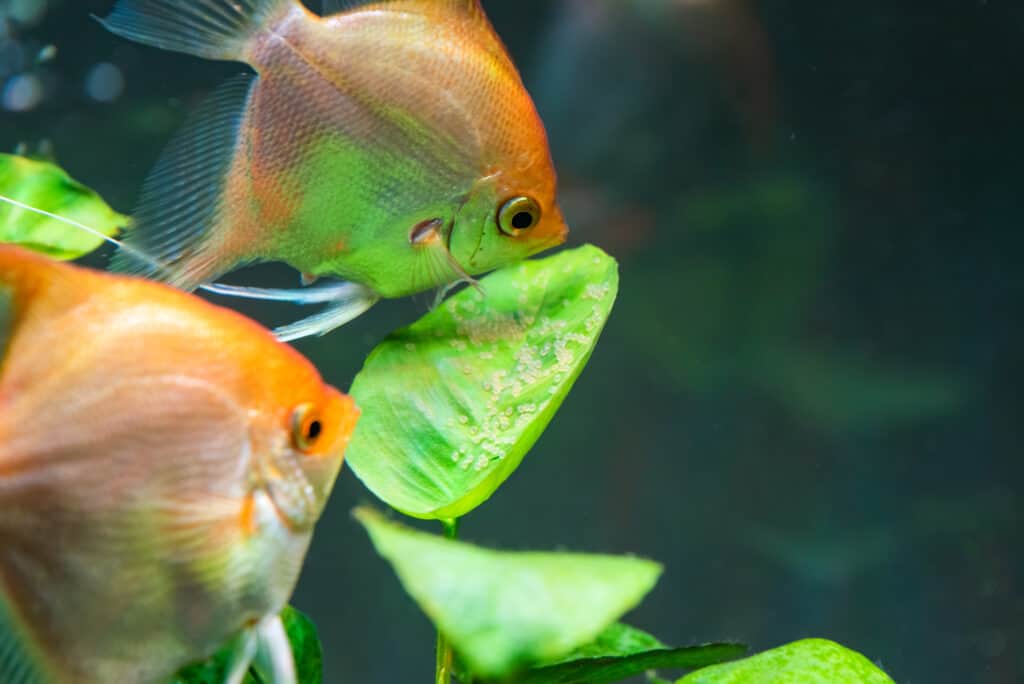Breeding angelfish is fun and rewarding. It is so interesting to watch the male and female angelfish working together taking care of their eggs and protecting their young. Angelfish are freshwater fish that lays eggs. Under the right condition, angelfish are not difficult to breed. Here is a step by step beginner’s guide on how to breed angelfish in 8 easy steps.
Step 1: How to Get a Breeding Pair of Angelfish
The first step to breeding angelfish is to get a breeding pair of angelfish. Angelfish will pair up and form lifelong partners. The first and most difficult part of the angelfish breeding process is to get a breeding pair of angelfish.
There are two ways to go about getting a breeding pair of angelfish. The first way is to raise young angelfish and wait for them to start pairing up. This is a slow process and can take months. Otherwise, you can buy a breeding pair of angelfish from the local breeder or pet store however, there is a risk that the breeding pair of angelfish end up losing their bond when they move to the new fish tank.
How to Get A Breeding Pair from a Group of Young Angelfish
Raise 6-8 young angelfish and house them in a 50 gallon tank. They will start to pair up when they get a little older (body size of around 1.5 to 2 inches diameter). The process of getting breeding pairs from a group of young angelfish can take 5-7 months. It is a slower process and the results will vary. There is a chance you only get 1 breeding pair out of 6 angelfish or you can get lucky and get 3 breeding pairs out of 6 angelfish. In order to increase the likelihood that your angelfish pair up, just start off with more angelfish. The angelfish pairing process takes months but it is less expensive than buying a breeding pair of angelfish from the breeder.
Use Our Angelfish Tank Size Calculator to figure out the tank size needed for your angelfish.
Step 2: How to Prepare the Fish Tank for Angelfish to Lay their Eggs
Once the angelfish pair up, they will stake out their territory. You should have smooth surfaces for them to lay their eggs on such as the leaves of Amazon sword plants or a breeding cone.
Step 3: Feed Angelfish High Protein Food to Prepare them for Breeding
Prepare your angelfish for breeding by feeding them high protein food. This can be done by feeding your angelfish a combination of tropical flakes and bloodworms. Live foods or frozen bloodworms are great but if you don’t want to handle the mess of live food, freeze dried bloodworms are also a good alternative. This process of prepping your angelfish can take 1 to 2 weeks and you will notice your angelfish growing bigger and fatter.
Step 4: Sit Back and Wait for Angelfish to Lay their Eggs
This is my favorite part of the angelfish breeding process. Watch your angelfish everyday and wait for them to lay their eggs. When it is close to when they will start to lay eggs, you will see your angelfish prepare the surface area of where they will lay their egg. Both angelfish will start cleaning and fussing over a leaf or a smooth surface (like the breeding cone). The female angelfish will start looking fatter and fatter. Then one day, you will wake up to see little eggs on a leaf or on the breeding cone. It’s fun to watch the angelfish fussing over the eggs, fanning the eggs to prevent fungal growth.

Step 5: Separate Angelfish Eggs from Parents or Keep Eggs With the Angelfish Parents
You should decide if you want to keep the eggs with the angelfish parents or separate the eggs and move them to a different tank. Below are scenarios of when to separate angelfish eggs from parents versus keeping the eggs in the same fish tank as the parents.
When to Separate Angelfish Eggs from Parents
You should separate angelfish eggs from the parents if they are in a community tank with other fish. Once the eggs hatch and the fry are free swimming, there is a major risk that the angelfish fry will be eaten by the other fish in the community tank. So if you have angelfish eggs in a community tank, it is safest to separately the angelfish eggs from the parents and hatch them in a smaller tank.
Another reason to separate angelfish eggs from the parents is when the parents are new parents. It usually takes a few breeding cycles for new angelfish parents to figure out how to take care of their fry. You risk losing angelfish fry if you leave the eggs with the parents. Don’t be surprised if they eat their baby fry because their parental instincts may not kick in until a few breeding cycles later. If you want high survival rate of angelfish fry, then separate the angelfish eggs from the parents.
When to Keep Angelfish Eggs with Parents
The main reason to keep angelfish eggs with the parents is so you don’t burden yourself with the extra work of having to care for another fish tank. The angelfish pair will naturally do the work by taking care of angelfish fry for you. Angelfish will take care of the eggs. It is a lot of fun to watch the entire process so if you don’t mind losing some fry or waiting a few breeding cycles until the angelfish parents get the breeding process right, then you should keep the eggs with the angelfish parents.
Another reason to keep the eggs with the parents is if the eggs are in a spot that in unmovable. For example, sometimes, angelfish will lay their eggs on the glass of the fish tank. When that happens, it is really hard to move the eggs so you have no choice but to leave the eggs with the parents.
Step 6: How to Separate Eggs from Parents
To separate eggs from parents, you should move the entire object where the eggs are on. For example, if the eggs are on a leaf of a sword plant then you can move the entire plant to another tank. Make sure that tank is small (less than 5 gallons). Don’t turn on the filter, you don’t want to disturb the eggs. Another method is to transfer the eggs to a mason jar and then once the fry are free swimming you can then move them to a small tank. In order to prevent fungus growth on eggs, add a few drops of Methylene Blue.
If you are leaving the eggs with the parents, you can skip this step and move to Step 7.
Step 7: How to Take Care of Angelfish Fry
It takes 2 days for angelfish eggs to hatch. Once they hatch, the angelfish are wigglers which are eggs with little tails. They will feed on their own yolk sacs. Then they will become free swimming angelfish fry and that is when you have to start feeding them fish food. Here are things to do to take care of angelfish fry.
Feed Angelfish Fry 3 to 4 Times a Day
Feed your angelfish fry crushed tropical flakes or baby brine shrimp. I usually feed my angelfish fry these specially formulated newborn fish food. Feed your angelfish fry 3 to 4 times a day to get them to grow as big as they can.
Change Water of Angelfish Fry Tank Every 2-3 days
Change 10% of the water of your angelfish fry tank every 2-3 days. This will keep the water condition optimal for the fry to grow.
Use Sponge Filter in Angelfish Fry Tank
Use Sponge filter in the Angelfish Fry tank. The sponge filter will prevent angelfish fry from being sucked up. Don’t use the regular filter, it is too strong for the angelfish fry tank.
Step 8: Enjoy
This final step is the main reason why lots of people breed angelfish. It is a very rewarding process to watch the angelfish parents take care of their young. It is also really fun to watch the little angelfish fry swimming around the fish tank.
Other Questions about Breeding Angelfish
How Many Eggs Do Angelfish Lay?
Angelfish can lay around 300 eggs in a single lay. Sometimes they may lay less or more but from my experience angelfish will lay around 300 eggs each time.
Will Angelfish Eat their Own Eggs?
Angelfish will not eat their own eggs. In fact, both male and female angelfish will take care of their eggs and protect it. However, if this is the first time for the angelfish pair, they will need a few tries before getting it right as parents. The angelfish pair will need to go through a few breeding cycles before their parental instincts properly kicks in, so don’t be surprised if they eat their own eggs in the beginning. If you don’t want to wait and want to ensure maximum angelfish eggs survival rate, you can take the eggs out and hatch them in a separate tank.
How Many Days Until Angelfish Eggs Hatch?
It takes 2 days for angelfish eggs to hatch. After hatching, the angelfish fry are called wigglers. The angelfish wigglers are tiny eggs with little tails. Angelfish wigglers feed on their yolk sac. The wigglers phase will last 5 days. After that, the angelfish wigglers turns into free swimming fish.
How to Tell the Difference Between a Male and Female Angelfish
It’s hard to tell the difference between male angelfish and female angelfish. The gender of the angelfish becomes evident when they are spawning. In general, male angelfish have a larger hump on their head and they are bigger. Another way to tell the difference between male and female angelfish is to look at the tubes that comes out of their underside. The female angelfish tube is rounder and wider while the male angelfish tube is more pointy and narrow. These tubes are really small and are visible when they are breeding so it is really hard to distinguish between male and female angelfish.
Is it Better to Remove Angelfish Eggs and Keep in a Separate Tank to Hatch?
I think it is better to move the angelfish eggs to a separate tank to hatch. By moving angelfish eggs to a separate tank, you increase the chance of survival of your angelfish fry when they hatch. If you were to keep the eggs with the Angelfish parents, you take the risk of the fry being eaten specially if there are other fish in the same tank.
How to Set Up Angelfish Fry Tank
Get an aquarium that is 5 gallons or less for your angelfish fry. Set up the angelfish fry tank with a sponge filter and water heater. Use the water heater to keep the water warm in the Angelfish fry tank at 78-82F. The sponge filter will prevent angelfish fry from being sucked up. The smaller tank will ensure that the tank is not too big that your angelfish fry will have difficulty getting to the food. Do frequent water changes, every 2-3 days, to maintain optimal water quality.
You May Also Be Interested in:
